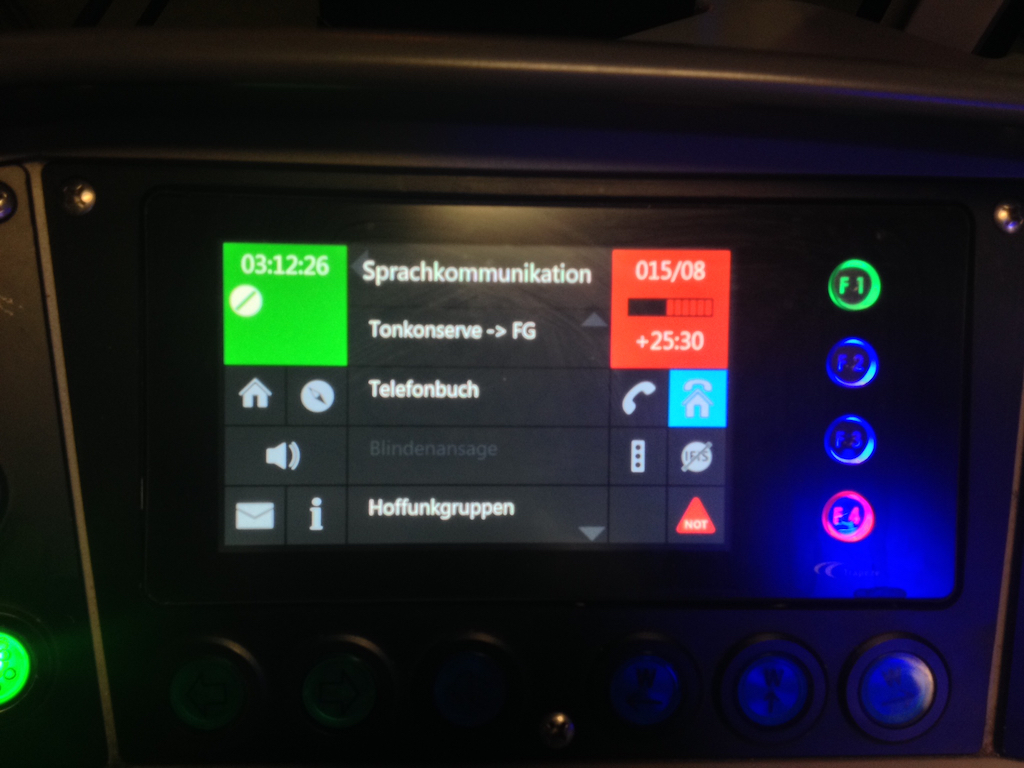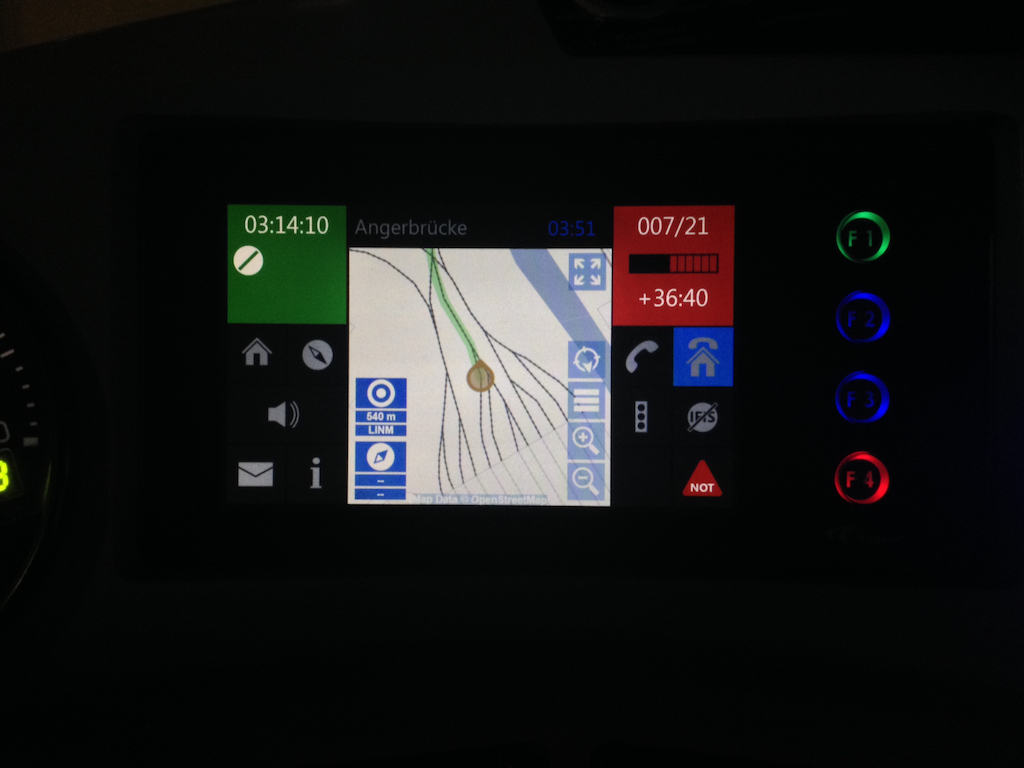ITCS is Key – an overview
Morning all, just…
I think a while ago, I promised to provide a bit of an illustration of how the onboard ITCS terminals on our trams work, intended to allow a bit of insight into the workings of public transport today. There are, of course, numerous different types of ITCS equipment available, though their functional principles are, largely, identical, I suppose.
Covering a bit of terminology first, I'd like to begin by outlining that in German, the traditional term for that which in English is now called ITCS – Intermodal Transport Control System – has long been "RBL", written out as "Rechnergestütztes Betriebsleitsystem" and appropriately translated as "Computerised Operational Direction System." While technical documents issued by the German Association of Public Transport Operators ("Verband Deutscher Verkehrsunternehmen", VDV) have largely adopted the English term ITCS since about 2005, RBL will, of course, still be understood to refer fundamentally to the same thing. I am also aware of the English designations of Computer-Aided Dispatch and Automatic Vehicle Location (CAD/AVL) and Automatic Vehicle Location System (AVLS), which also describe key elements of this suite of applications.
Whichever of these designations one may prefer use, ITCS is, basically, a unified suite of operational information and communication, operational direction and multi-channel passenger information systems.
For exchange of information and communications, ITCS installations – which in detail may be tailored to the specific requirements of any given transport network – will utilise either analogue radio transmission or, for newer implementations, Terrestrial Trunked Radio or GSM. Communication includes direct voice communication between Control and individual drivers, as well as data transmission such as vehicle position data or datagrams for text-based instructions. Such communications can also be directed to specific lines or bundles of lines for general information of interest to the relevant staff members, as in the event of disruptions in a specific location and affecting only certain lines.
Vehicle location and travel time prediction is usually achieved through fixed lineside infrared beacons and corresponding onboard transceivers, now frequently augmented by GPS locating devices. This real-time information is then generally compared with stored routing and timetabling information for each individual line. Depending on how the centralised processing systems are configured, these can then automatically instruct drivers to wait for connecting services, and/or allow control operators to make such decisions as required. Such operational instructions can, again, be provided either by voice communication or by text messages which would be displayed on the onboard terminals.
As I believe I mentioned elsewhere, it's also worth mentioning that in Germany at least, tram systems are normally configured such that points are set by data transmission from each individual car to the point control units, and that centralised route setting, as would be present on railways or "Stadtbahn" (light rail) and genuine underground systems, in turn, does not exist.
For point control, some tram operators prefer to provide manual setting only, meaning that drivers must set each point by pressing one of either two or three buttons provided on the cab desk as they approach. If memory serves, Basel, Darmstadt, Dresden and Munich are examples for cities where only manual point setting is available.
Other cities, such as Leipzig and Frankfurt, provide automatic point setting, though point control buttons are still provided for backup and for use in the event of diversions and for departmental services. For automatic point setting, the onboard transponder is tied into the ITCS terminal to provide the point control units with information as to which way each relevant point along the service's path must be set for it to be directed to its destination.
This year, LVB have upgraded their ITCS suite, which for full capabilities to be exploited also required our trams and buses to be outfitted with new onboard terminals. In Leipzig, Swiss transport information system producer Trapeze was chosen to provide these terminals, with trams having been fitted with the Intelligent Touch Terminal sets and buses being fitted with the ticontrol.500 combined ITCS terminals and ticket printers. Buses are still being refitted at this time, while the tram refit was concluded by the end of this summer. The ITT and ticontrol sets are both controlled through a touch screen for menu navigation and data entry, rather like smartphones and tablet computers.

This is essentially the "home" screen once you have entered your turn number, which in this example was 1508. Once you have done so, the terminal automatically accesses the relevant set of timetables and routing information for the entire duration of the turn's operation on a given day (as timetables and routes can, and often do, differ between individual days of a week). In this example, I had 25 minutes to spare till depot sortie.
The home screen can be accessed from any menu by pressing the "house" icon to the left. The icons below the turn number and punctuality field to the right are:
- communication request to Control (phone receiver icon)
- communication request to depot supervisor (phone receiver above house icon – available only if this icon is shown with a light blue background)
- manual signal priority request (traffic light icon – lineside equipment not enabled for this function yet)
- pause passenger information system (dashed "IFIS" icon)
-
emergency communications request to Control, to be used in the event of accidents with casualties (red triangle with "Not" text icon)

This menu for Voice Communication is accessed using the "loudspeaker" icon to the left. The topmost icon in the list directs you to a submenu where you can select from a total of 46 pre-recorded passenger service announcements, such as requests to keep wheelchair spaces clear, to clear the doorways and move further into the car, or to inform passengers of obstructions on the line or waiting for connecting services.

The second item in the Voice Communications menu opens the Phone Directory as the ITT devices conveniently offer a mobile telephone function as well. Theoretically, you can call any person within the company through the ITT sets.
The directory which is available comprises relevant phone numbers such as staff dispatcher or depot supervisors – so for obvious reasons, I edited this image to conceal these numbers.

The "envelope" icon to the left opens the Mailbox menu where you can access all text messages you may have received during your shift – though it is recommended to delete messages regularly once you have acknowledged them and do not need them any longer.
You can also send text messages yourself by selecting the third list item. These can either be one of the following: "Yes", "No", "Malfunctioning ticket machine", "Request technician", "Arrived at destination", "Infrastructure report request", "Short turn request", "Traffic congestion" and "Overcrowding"; and you can also send free-text messages which you compose using a virtual keyboard on the terminal's display. You should, however, keep such messages as short as possible.

Furthermore, the "compass" icon opens the Navigation module which might look slightly out of place on a tram and is, as far as I know, simply a feature provided on the ticontrol terminals on our buses and carried over to the ITT units for convenience. It's interesting to note that, for one, the Navigation module utilises Open Street Map data, and that you can even enable voice directions as on automobile sat navs. Of course, this navigation module can be quite useful for buses in particular, especially during diversions utilising unusual or otherwise complex routes.
Well, I hope I could outline another aspect of the technical means relevant to my work, and perhaps improve understanding how modern public transport works. ![]()
-
 3
3




0 Comments
Recommended Comments
There are no comments to display.
Create an account or sign in to comment
You need to be a member in order to leave a comment
Create an account
Sign up for a new account in our community. It's easy!
Register a new accountSign in
Already have an account? Sign in here.
Sign In Now